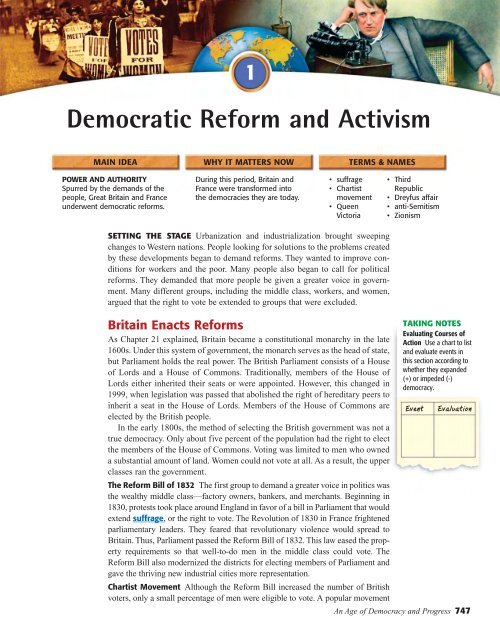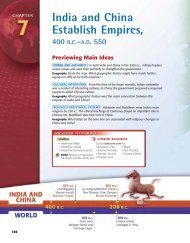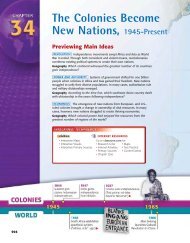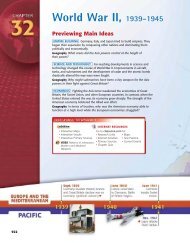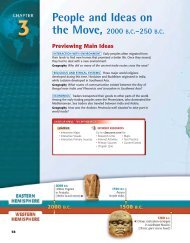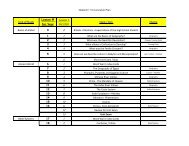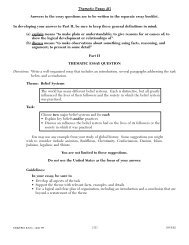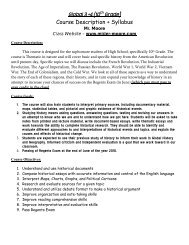The Industrial Revolution, 1700– 1900 Previewing Main Ideas
The Industrial Revolution, 1700– 1900 Previewing Main Ideas
The Industrial Revolution, 1700– 1900 Previewing Main Ideas
You also want an ePaper? Increase the reach of your titles
YUMPU automatically turns print PDFs into web optimized ePapers that Google loves.
MAIN IDEA WHY IT MATTERS NOW TERMS & NAMES<br />
POWER AND AUTHORITY<br />
Spurred by the demands of the<br />
people, Great Britain and France<br />
underwent democratic reforms.<br />
1<br />
Democratic Reform and Activism<br />
During this period, Britain and<br />
France were transformed into<br />
the democracies they are today.<br />
• suffrage<br />
• Chartist<br />
movement<br />
• Queen<br />
Victoria<br />
SETTING THE STAGE Urbanization and industrialization brought sweeping<br />
changes to Western nations. People looking for solutions to the problems created<br />
by these developments began to demand reforms. <strong>The</strong>y wanted to improve conditions<br />
for workers and the poor. Many people also began to call for political<br />
reforms. <strong>The</strong>y demanded that more people be given a greater voice in government.<br />
Many different groups, including the middle class, workers, and women,<br />
argued that the right to vote be extended to groups that were excluded.<br />
Britain Enacts Reforms<br />
As Chapter 21 explained, Britain became a constitutional monarchy in the late<br />
1600s. Under this system of government, the monarch serves as the head of state,<br />
but Parliament holds the real power. <strong>The</strong> British Parliament consists of a House<br />
of Lords and a House of Commons. Traditionally, members of the House of<br />
Lords either inherited their seats or were appointed. However, this changed in<br />
1999, when legislation was passed that abolished the right of hereditary peers to<br />
inherit a seat in the House of Lords. Members of the House of Commons are<br />
elected by the British people.<br />
In the early 1800s, the method of selecting the British government was not a<br />
true democracy. Only about five percent of the population had the right to elect<br />
the members of the House of Commons. Voting was limited to men who owned<br />
a substantial amount of land. Women could not vote at all. As a result, the upper<br />
classes ran the government.<br />
<strong>The</strong> Reform Bill of 1832 <strong>The</strong> first group to demand a greater voice in politics was<br />
the wealthy middle class—factory owners, bankers, and merchants. Beginning in<br />
1830, protests took place around England in favor of a bill in Parliament that would<br />
extend suffrage, or the right to vote. <strong>The</strong> <strong>Revolution</strong> of 1830 in France frightened<br />
parliamentary leaders. <strong>The</strong>y feared that revolutionary violence would spread to<br />
Britain. Thus, Parliament passed the Reform Bill of 1832. This law eased the property<br />
requirements so that well-to-do men in the middle class could vote. <strong>The</strong><br />
Reform Bill also modernized the districts for electing members of Parliament and<br />
gave the thriving new industrial cities more representation.<br />
Chartist Movement Although the Reform Bill increased the number of British<br />
voters, only a small percentage of men were eligible to vote. A popular movement<br />
• Third<br />
Republic<br />
• Dreyfus affair<br />
• anti-Semitism<br />
• Zionism<br />
TAKING NOTES<br />
Evaluating Courses of<br />
Action Use a chart to list<br />
and evaluate events in<br />
this section according to<br />
whether they expanded<br />
(+) or impeded (-)<br />
democracy.<br />
Event Evaluation<br />
An Age of Democracy and Progress 747


